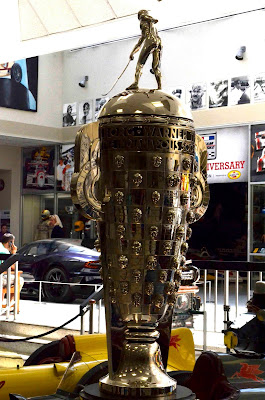Years ago, before the annual Memorial Day 500 mile race was featured on television, radio was the only way to follow the event from flag to flag. Herb Cain, a writer for the San Francisco Chronicle, did not like the race and used to point out that, if the cars left City Hall, some of them would have broken down before they made it out of The City, much less 500 miles. Being a young man who loved cars and racing, the Indy was still a must do for me.
I was always partial to A. J. Foyt and was thrilled when he won in 1961 and again in 1964. Family, raising children and work took the place of the Indy in the great scheme of things but I always wanted to tour the Brickyard as it is called and actually take a turn on the track. Well, that hope was finally realized when we arrived at the Speedway.
I was told, by Speedway representatives that, when I entered the track’s address in the GPS, be sure to enter the city as Speedway, not Indianapolis. Speedway, it seems, has its own zip code, post office and is a small city with a bit more than a speedway in it.
Our tour started with a visit to the museum where many of the winning cars are displayed. This is the 2015 winner. Also in the museum is the famous Borg Warner Trophy which carries a relief of the face of each of the 100 winners. They ran out of space in the 80s so they added a base for more faces. They now have enough room to go to 2031.
We were taken on a bus ride through the complex, to the press rooms,
the new pagoda which houses the scoring computers and other facilities,
the pit area and then the winners news conference stand where first, second and third give their statements to the press.
Finally, we were then taken on a single lap of the track. The bus was somewhat slower than the 240 mph that the Indy cars make and, in fact, we were told that in the time of our lap, a race car would do about 17 laps. It was still a thrill.
This is the view down the main straight. The entrance to the pit area is on the left and this is where the driver who wants to make a pit stop slows down to a mere 60 mph.
The only “brick” part of the track is a single three foot wide strip going across it and it is preserved so that it can still be called the brickyard.
Anna Lee and I enjoyed having our photos taken standing on the bricks while others in our group “kissed” the bricks
The starter’s stand is just above the bricks and is the home of what is now celebrity starters. The starter just waves a green flag and then usually leaves the stand. He or she is given only one instruction: DON’T DROP IT.
The drivers don’t watch for the flag however as they don’t want to take their eyes off the car in front of them so the track has traffic signals on the wall within the drivers' field of vision. When the light goes green, the race is on.
What was interesting was that the Hulman family still owns the entire complex even though Tony Hulman, who used to say “Gentlemen, start your engines” died in 1977.
First his wife and now his daughter became CEOs.
Here are a few of the winning cars that were in the museum. The first is a Marmon, the first one to win in 1911. A lot has changed over the years. As an aside, there have been only 100 winners from 1911 to 2016 because there were no races while WW II was being fought. This year marked the actual 100th running.
We parked the RV in a parking lot next to a small home so that we could unhook the tow car and drive it into the museum parking lot. The house is very modest but we assume it is sufficient for the Hulman family who stay there for a few weeks a year.


















No comments:
Post a Comment